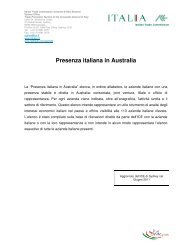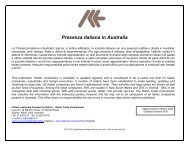Price Determination in the Australian Food Industry A Report
Price Determination in the Australian Food Industry A Report
Price Determination in the Australian Food Industry A Report
You also want an ePaper? Increase the reach of your titles
YUMPU automatically turns print PDFs into web optimized ePapers that Google loves.
Examples <strong>in</strong>clude:<br />
• 1 litre milk – this now represents a small share of <strong>the</strong> category alongside <strong>the</strong> dom<strong>in</strong>ant 2 and 3<br />
litre conta<strong>in</strong>ers <strong>in</strong> most retail outlets.<br />
• Processed cheese slices – processed cheese now accounts for about a quarter of <strong>the</strong> total<br />
category, whereas dom<strong>in</strong>ant product sales are made <strong>in</strong> natural cheese blocks. It is also a<br />
product that is less reflective of cheese market conditions.<br />
• Frozen chicken – fresh chicken portions are now <strong>the</strong> dom<strong>in</strong>ant product category as a result of<br />
<strong>the</strong> ga<strong>in</strong>s <strong>in</strong> process<strong>in</strong>g and packag<strong>in</strong>g technology.<br />
• Oranges – <strong>the</strong>re are two major varieties of orange (valencia and navel) which are affected by<br />
very different supply and demand dynamics due to seasonal factors and <strong>the</strong> effect of <strong>the</strong> juice<br />
market as a consumer of partial output of both varieties. Greater consistency and clarity of juice<br />
variety and pack form would aid use of <strong>the</strong> published data.<br />
There is a substantial body of unpublished ABS data which is used for various purposes. It would<br />
be advantageous to explore <strong>the</strong> possibility of mak<strong>in</strong>g some of that data available to <strong>in</strong>dustries as<br />
part of a process of improv<strong>in</strong>g <strong>in</strong>formation flows regard<strong>in</strong>g <strong>the</strong> size and value of <strong>in</strong>dustry output,<br />
pric<strong>in</strong>g and value added.<br />
VALUE-ADDING AND INNOVATION<br />
<strong>Food</strong> manufacturers and marketers value-add to stay alive. The nature and extent of competition <strong>in</strong><br />
<strong>the</strong> grocery food <strong>in</strong>dustry and <strong>the</strong> directions be<strong>in</strong>g taken <strong>in</strong> <strong>the</strong> domestic retail grocery market<br />
<strong>in</strong>dicate clearly that enterprises will cont<strong>in</strong>ue to <strong>in</strong>novate beyond core or staple products.<br />
‘Value-add<strong>in</strong>g’ is a much-misused term and has become jargonised <strong>in</strong> recent years. It is important<br />
to dist<strong>in</strong>guish between <strong>the</strong> follow<strong>in</strong>g forms of value-add<strong>in</strong>g:<br />
a) strategies to substantially differentiate products for sale <strong>in</strong>to specific or targeted market<br />
segments;<br />
b) strategies to fur<strong>the</strong>r process commodity products to a form which is closer to <strong>the</strong> f<strong>in</strong>al<br />
consumer product; and<br />
<strong>Price</strong> <strong>Determ<strong>in</strong>ation</strong> <strong>in</strong> <strong>the</strong> <strong>Australian</strong> <strong>Food</strong> <strong>Industry</strong> A <strong>Report</strong><br />
c) strategies to enhance <strong>the</strong> recovery and return from process<strong>in</strong>g <strong>the</strong> whole commodity or its<br />
functional components, through process<strong>in</strong>g lower grade, waste or by-products and manag<strong>in</strong>g<br />
<strong>the</strong> overall consumption of a raw material by convert<strong>in</strong>g a short shelf-life product to storable<br />
form.<br />
Items (a) and (b) are areas where greatest attention is paid to <strong>the</strong> concept of value-add<strong>in</strong>g <strong>in</strong> <strong>the</strong><br />
food sector.<br />
The basic aim of <strong>the</strong>se forms of value-add<strong>in</strong>g is to create a substantial benefit to <strong>the</strong> next user or<br />
end user of <strong>the</strong> product – that may be sav<strong>in</strong>g time and/or cost, or provid<strong>in</strong>g some sort of<br />
<strong>in</strong>cremental benefit from <strong>the</strong> product – health advantage, taste, versatility or storage life. Given <strong>the</strong><br />
concentration <strong>in</strong> <strong>the</strong> retail sector and <strong>the</strong> strong pressure on marg<strong>in</strong>s for participants <strong>in</strong> commodity<br />
food l<strong>in</strong>es, (a) and (b) type value-add<strong>in</strong>g is vitally important to many food marketers and<br />
processors.<br />
There is accord<strong>in</strong>gly extreme reluctance to share with this project commercially sensitive<br />
<strong>in</strong>formation as to <strong>the</strong> dest<strong>in</strong>ation of returns from such efforts. The analysis of <strong>the</strong> share of returns<br />
from such <strong>in</strong>novations is mostly without quantification for that reason.<br />
Such is <strong>the</strong> nature of competition <strong>in</strong> <strong>the</strong> food retail market (domestic and <strong>in</strong>ternational) that <strong>the</strong><br />
competition for a susta<strong>in</strong>able value-add<strong>in</strong>g product is <strong>in</strong>tense.<br />
128







